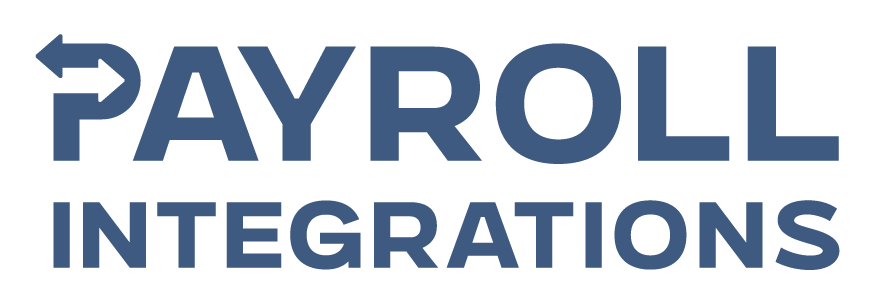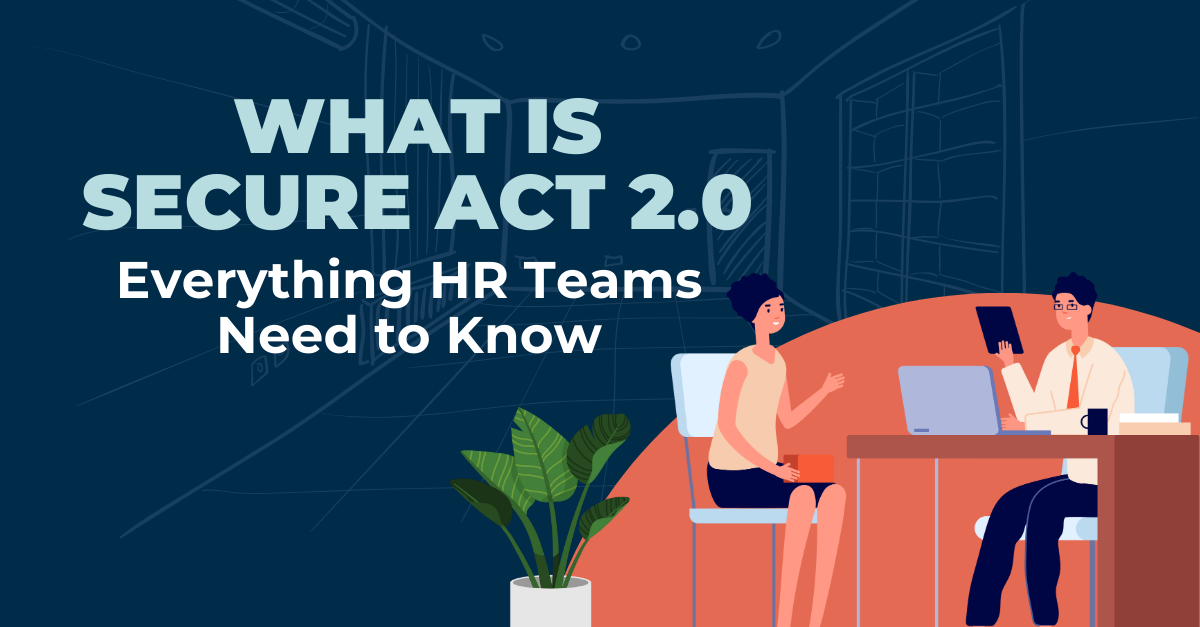Have you heard of the Secure Act 2.0? This sweeping reform package adds over 90 new retirement plan provisions and marks a big step forward in improving retirement security for American workers.
This article explores the most essential elements of the Secure Act 2.0 and highlight key improvements that will keep your organization compliant and competitive.
What Is Secure Act 2.0?
The Secure Act 2.0, also known as the "Setting Every Community Up for Retirement Enhancement Act of 2022," is a piece of US legislation designed to improve retirement savings and financial security for American workers.
It builds on the 2019 SECURE Act and introduces new provisions aimed at removing the barriers keeping most Americans from saving for retirement.

The new legislation addresses a wide range of retirement plan features, extends benefits to more people and offers more flexibility in managing retirement accounts.
Key provisions of Secure Act 2.0 include changes to required minimum distributions (RMDs), increased catch-up contributions, automatic enrollment in retirement plans and new rules for part-time employees, among others.
Why Secure Act 2.0 Matters for HR Teams
Secure Act 2.0 introduces a range of changes that have far-reaching implications for how retirement plans are managed, communicated and administered within organizations.
For HR teams, understanding and implementing these changes is not just a matter of regulatory compliance but also an essential component of supporting employees’ financial well-being and enhancing the overall employee experience.
Secure Act 2.0: 10 changes you should know

1. Automatic enrollment and auto-portability are now the law of the land
There are two major ‘headline’ provisions from SECURE Act 2.0. First, auto-enrollment in plans—as well as auto-portability—is now effectively Federally mandated.

Auto-enrollment now starts at a minimum of 3% of one’s pay. Auto-portability, meanwhile, ensures that when an employee leaves a job, they can now roll it over into their new employer’s 401k retirement plan. While that is not new, it is now easier.
By mandating enrollment, American workers will invariably become better prepared for retirement.
However, some employees may be frustrated by the mandated deductions. Your team will also experience a greater administrative burden in complying with mandated enrollment. You can ensure your team is prepared for this challenge by increasing administrative capacity and investing in new tools and solutions aimed at improving processes.
2. The RMD age is now 73—and set to go higher
A second, deeply impactful provision of the act is the raising of the Required Minimum Distribution (RMD) age. The age was increased to 73 as of 2023 and is set to gradually increase to 75 by 2033. By increasing the RMD, individuals now have additional time to prepare tax-free for their retirements.

Like the switch to automatic enrollment, a revision to the RMD age this significant has major implications for you and your team’s compliance and administration.
You must ensure the plans you offer are fully compliant. Your team must also account for how RMD changes impact effective strategic retirement planning when discussing employee financial wellness.
3. Retirement access for ‘long-term part-time’ workers
Individuals working part-time for a long period—such as waitresses and retail associates—have historically been unable to access employee-sponsored retirement plans whatsoever.

The act provides retirement access to millions of ‘long-term part-time’ workers provided they’ve worked 500 (but not more than 1,000) hours per year for the last three years.
This is a temporary limit that will be bumped down to two years by 2025. This is another provision that could require your HR teams to manage a greater number of retirement accounts than they once would have.
4. Additional provisions to reduce fees for retirement savers
First, if an employee has an employer-sponsored Roth account as part of their retirement plan, those accounts are no longer subject to RMDs at all.

Second, for all accounts that are subject to RMDs, there are now reduced RMD penalties if you miss a mandated withdrawal from 50% to 25%.
There is a two-year window to correct errors and reduce penalties to 10%. Altogether, these measures help financially support employees in their financial planning.
5. Expanded and more lenient emergency savings and withdrawal provisions
The act also allows for emergency withdrawals without penalties or fees. Starting this year, employees can now withdraw a maximum of $1,000 from their retirement accounts for personal or family emergencies up to once per year. Three years are provided to repay any such withdrawals as tax-free rollover distributions.

However, another emergency withdrawal won’t be possible during that time if the initial withdrawal is not repaid. Participants do not need to show an emergency to receive these benefits according to Department of Labor FAQs.
Participants in defined contribution plans (e.g., 401k plans) can also now set up emergency savings plans as Roth retirement accounts that allow four penalty and tax-free distributions per year with $25,00 as the max yearly contribution limit.
As HR managers and strategists, be sure to communicate these changes to employees to better the chances they will take advantage of these financial tools and, ultimately, continue to improve their financial wellness.
6. Individuals nearing retirement can play “Super Catch-Up”
SECURE Act 2.0 introduced ‘Super Catch-Up Contributions’ in anticipation of a growing number of plan participants not meeting their targets as they near retirement age.

Current IRS regulations limit catch-ups for those aged 50 and older to $7,500 per year. By 2025, employees aged 60-63 can contribute at the super catch-up rate of more than $10,000, or 150% of the regular catch-up amount. If an employee makes more than $145k per year, however, catch-up contributions must go to a Roth account rather than a pre-tax account.
While a boon for retirement savers, this provision is one of the more administratively taxing for your HR teams as it requires them to track different catch-up rates for different ages for the first time ever. Complex compliance provisions such as these benefit significantly from solutions that help to automate retirement benefits provision.
7. Employer-sponsored Roth retirement account contribution changes
If you offer a Roth account as part of your company’s 401k (remember, this is distinct from a Roth IRA), your plan participants can receive matching contributions. As managers, this provision offers another tool in your toolbox to boost employee satisfaction while attracting new talent.

Additionally, 529 plans can now be rolled into Roth IRAs after 15 years. These plans no longer require withdrawals (up to $35,000) providing the funds have been in the 529 for 5 years. The beneficiary must also be the same as the 529.
This update is a great opportunity for you and your team to communicate another financial strategy employees may not know about. It is of special interest to employees looking to start saving early for their children.
8. New ways for employers to contribute to younger employees’ financial wellness
In addition to the matching contribution rule for Roth accounts, your company can also now make matching payments for student loans (effectively treating them as elective deferrals).

This is a potentially huge boost to financial employee wellness for younger employees. It’s also yet another new strategy for companies looking to attract new fresh talent.
Retirement contributions can also be matched with student loan payments to ensure employees are achieving the dual financial goals of preparing for retirement and repayment.
9. New rules for Qualified Charitable Distributions
With Secure Act 2.0, Qualified Charitable Distribution (QCD) rules are revised. Retirement savers can now take up to $100,000 from a retirement account and send it to their favorite charity in lieu of withdrawing funds under RMD rules. They can also take up to 50k and contribute it into a charitable remainder annuity trust.

To help foster a community of shared values, you and your HR team can inform employees of this opportunity to better leverage existing retirement funds as charitable contributions.
Your team could even consider opt-in workplace-driven charity drives leveraging this provision to promote shared causes, bringing your team closer together and creating excellent PR opportunities.
10. Changes to Qualified Longevity Annuity Contracts
There are several new changes to rules surrounding Qualified Longevity Annuity Contracts, or QLACs, a type of deferred income annuity. First and most significant, the maximum amount that can be invested has increased from $125,000 per year to $200,000, adjusted for inflation each year.

Because RMDs don’t start on QLACs until 85, this is another change that helps employees avoid RMDs. It’s also another opportunity for your team to communicate new retirement strategies to your employees.
Additionally, a previous 25% limit on tax-free retirement account transfers to purchase those QLACs is now entirely gone, as are joint and survivor participation in such plans now better facilitated. In general, the rules for QLACs are now streamlined, no longer involving a combination of percentages and total dollar amounts as limitations.
Keeping track of it all: where payroll integration tools and services come in
As an HR manager with plenty on their plate, if you’re looking at all of this and getting a headache, you’re not alone. Many HR departments already feel tapped when it comes to ensuring proper compliance, administration, and reporting.
Huge, sweeping changes to how retirement accounts are federally mandated don’t help. Worse, when your teams find themselves drowning in those administrative functions, they have less time to make more genuine connections with employees via face-to-face interactions, company culture-building events and critical mediation efforts.
That’s why automated, API-based payroll integration solutions and partnerships offer such a tremendous ‘leg up’ for all of your team’s day-to-day HR functions.
Universal Payroll APIs integrate multiple payroll services such as ADP and QuickBooks into a single, secure platform that can automate your team’s most tedious tasks in a way that is secure down to the infrastructural level.
Ultimately, changes to how employee benefits are provisioned are an ongoing reality for you and your team, especially in today’s volatile economy. The SECURE 2.0 act comes hot off the heels of SECURE 1.0, and more revisions may yet come.
No matter what those changes may be, however, having the right tools and partnerships in place to ensure you’re not only aware of those changes but ready to implement them quickly and accurately is a key readiness measure going forward.
With these API solutions in place, your team will thank you for freeing up the time and mental energy these administrative functions had demanded.
In return, they’ll be able to focus on the kind of relationship building that makes for a great workplace, from onboarding to updated training to crisis management and everything in between.


